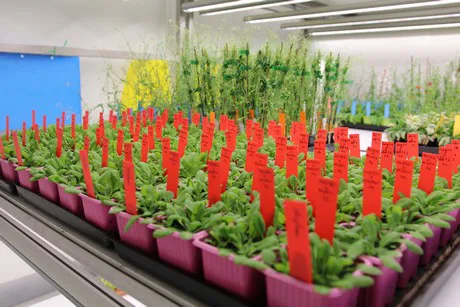The market is saturated with LED companies offering “white light” LED products. Many growers associate white LED light with a sunlight or daylight spectrum i.e. a replica of the light provided by the Sun. While it can be so, spectra appearing white to human eyes can differ greatly and thus induce entirely different responses on plants. This is dependent on their spectral compositions and the corresponding photoreceptors in plants. (For more information on why LED grow light is purple, read this related post.)

Some differentiation among white light spectra also occurs through different color temperatures (cool white, warm white, neutral white) or the difference perceived may be subjective depending on how sensitive people’s eyes are to notice these differences. The only way to definitively understand the DNA of light is by making measurements with spectrometers, which show the spectrum graph and photon distribution, as even spectra with same color temperature can have different spectrum graphs!
Using spectrometer data makes it easy to calculate parameters related to plant growth and plant development and allows the spectra comparison of the given white LED spectrum against measurements taken outdoors.
Plants absorb photon energy from the light and convert it into chemical energy in the process called photosynthesis. Furthermore, the light transmits signals to the plant about its immediate environment. Plants adapt their morphology and induce developmental processes such as flowering according to the light spectrum composition. For instance, the amount of green light in the spectrum will induce responses in plants such as stomatal closure, some shade avoidance symptoms, mitigation responses to blue light, signaling of competition from neighboring plants but also enhancing of photosynthesis by bringing the light into deeper cell layers. Additionally, it is exactly this green portion of the light spectrum which will make it appear white to human eyes. And this is also the answer to the question why most LED grow lights appear pink: they do not contain the green portion of the spectrum but typically only red and blue, giving them their signature pink hue.
The amount of green light will determine how white the spectrum will appear and all other color regions of the spectrum (blue, red, far-red) can differ in their proportion. This is the reason why plants can have different performances under different white light spectra, all of which appear identical to human eyes. A more detailed overview of how plants respond to different spectrum wavelengths can be found in many publications (Kami et al. 2010; Olle and Viršilė 2013; Demotes-Mainard et al. 2016; Bantis et al. 2018).
Following are some results of model plant trials conducted at Valoya. All the spectra used appeared white to human eyes but vary in spectra composition greatly, ranging from 370 to 780nm, meaning they have different amounts of UV, blue, green, red and far-red light.
- Plants: Arabidopsis thaliana and Amaranth
- Parameters tested: biomass accumulation, plant height and flower induction.
Biomass accumulation of Arabidopsis thaliana differs greatly under different white spectra. Growth under light sources created for human use such as fluorescent light (FL_840) or cool white LEDs (LED_CW) is inferior to the growth under other treatments. The treatments named LED_R:FR Low, Medium or High are altered Valoya white spectra. Spectra composition of LED_R:FR Low and Medium are white appearing spectra adapted for plant growth, whereas the spectrum of LED_R:FR High was specifically designed to be a highly accurate match to daylight conditions.
Why does light that appears to be the same elicit such different responses? The answer is in spectrum and the balance of various wavelengths within it. In developing a spectrum an LED company has to test various red-to-far-red and blue-to-green light ratios, amounts of each color in the spectrum, the height and width of the light peaks etc. Then only through experimentation can we learn what works and what does not. Finding a concrete answer how the spectrum was balanced might be futile as LED companies protect this data, naturally. Valoya has conducted 514 plant trials to date and commercialized 6 spectra. This technology is protected through 86 patents and mostly unavailable publicly.
Read the full article at valoya.com
Valoya will be exhibiting at IPM 2019. To see the latest in LED grow light innovations, visit them at booth 3B42.
